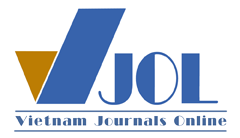Nonenzymatic formaldehyde sensors using nickel oxide based electrode fabricated by electrochemical method
DOI:
https://doi.org/10.51316/jca.2021.100Keywords:
Nickel oxide, ITO, formaldehyde, electrochemical sensorsAbstract
NiO materials were fabricated by electrochemical exfoliation combined with ultrasonic vibration to produce nano-sized particles. By electrophoresis, NiO particles dispersed in IPA solvent (isopropyl alcohol) were precipitated on the ITO substrate acting as the cathode. The morphology and structure of the materials were characterized by scanning electron microscope (SEM) and X-ray diffraction (XRD). The role of electrophoresis potential, electrophoresis time on electrode formation was investigated when studying the effect on electrochemical properties of the electrode for formaldehyde in aqueous solution. As a result, with the NiO dispersion system (0.1 g NiO in 50 mL IPA), the distance between the ITO electrode (negative electrode) and the Pt plate (positive electrode) of 2 cm, the electrophoresis potential of 10 V, electrophoresis time of 3 min is optimized for fabrication of NiO/ITO electrode in formaldehyde electrochemical sensor. Sensitivity and linear range at different electrode potentials were investigated when determining the concentration of formaldehyde in water.
Downloads
References
H. Singh, R. Yadav, S. Farooqui, O. Dudnyk, A. Sinha, Int. J. Hydrogen Energy 44 (2019) 19573-19584. https://doi.org/10.1016/j.ijhydene.2019.05.203
A. Ramu, M.A. Kumari, M.S. Elshikh, H.H. Alkhamis, A.F. Alrefaei, D. Choi, Chemosphere 271 (2021) 129475-129483. https://doi.org/10.1016/j.chemosphere.2020.129475
S.M. Roopan, G. Elango, D.D. Priya, I. Asharani, B. Kishore, S. Vinayprabhakar, N. Pragatheshwaran, K. Mohanraj, R. Harshpriya, S. Shanavas, J. Mol. Liq. 293 (2019) 111509. https://doi.org/10.1016/j.molliq.2019.111509
C. Kuang, W. Zeng, H. Ye, Y. Li, Physica E 97 (2018) 314-316. https://doi.org/10.1016/j.physe.2017.12.006
E. Turgut, Ö. Çoban, S. Sarıtaş, S. Tüzemen, M. Yıldırım, E. Gür, Appl. Surf. Sci. 435 (2018) 880-885. https://doi.org/10.1016/j.apsusc.2017.11.133
D. Meng, D. Liu, G. Wang, Y. Shen, X. San, M. Li, F. Meng, Sens. Actuators, B 273 (2018) 418-428. https://doi.org/10.1016/j.snb.2018.06.030
M. Wang, Y. Ma, Y. Fo, Y. Lyu, X. Zhou, Int. J. Hydrogen Energy 45 (2020) 19357-19369. https://doi.org/10.1016/j.ijhydene.2020.05.131
W. Chen, Y. Wu, J. Fan, A.B. Djurišić, F. Liu, H.W. Tam, A. Ng, C. Surya, W.K. Chan, D. Wang, Adv. Energy Mater 8 (2018) 1703519. https://doi.org/10.1002/aenm.201703519
Z. Zhu, E. Guo, Z. Wei, H. Wang, J. Power Sources 373 (2018) 132-138. https://doi.org/10.1016/j.jpowsour.2017.10.091
R. Ahmad, M. Khan, N. Tripathy, M.I.R. Khan, A. Khosla, J. Electrochem. Soc. 167 (2020) 107504. https://doi.org/10.1149/1945-7111/ab9757
Z. Li, Vacuum 143 (2017) 50-53. https://doi.org/10.1016/j.vacuum.2017.05.038
R.L. Fomekong, H.T. Kamta, J.N. Lambi, D. Lahem, P. Eloy, M. Debliquy, A. Delcorte, J. Alloys Compd. 731 (2018) 1188-1196. https://doi.org/10.1016/j.jallcom.2017.10.089
Y. Xu, X. Tian, Y. Fan, Y. Sun, Sens. Actuators, B 309 (2020) 127719. https://doi.org/10.1016/j.snb.2020.127719
V. Sibirny, O. Demkiv, H. Klepach, T. Honchar, M. Gonchar, Food Chem. 127 (2011) 774-779. https://doi.org/10.1016/j.foodchem.2010.12.146
M. Baez-Gaxiola, C. Fernández-Sánchez, E. Mendoza, Ana. Methods 7 (2015) 538-542. https://doi.org/10.1039/C4AY02023E
H. Mei, W. Wu, B. Yu, H. Wu, S. Wang, Q. Xia, Sens. Actuators, B 223 (2016) 68-75. https://doi.org/10.1016/j.snb.2015.09.044
D. Trivedi, J. Crosse, J. Tanti, A.J. Cass, K.E. Toghill, Sens. Actuators, B 270 (2018) 298-303. https://doi.org/10.1016/j.snb.2018.05.035
Š. Trafela, J. Zavašnik, S. Šturm, K.Ž. Rožman, Electrochim. Acta 309 (2019) 346-353. https://doi.org/10.1016/j.electacta.2019.04.060
S.A. Al-Jendan, W. Alarjan, I. Elghamry, A. Touny, M. Saleh, M.E. Abdelsalam, Int. J. Hydrogen Energy 45 (2020) 14320-14333. https://doi.org/10.1016/j.ijhydene.2020.03.141
M.A. Ehsan, A. Rehman, Ana. Methods 12 (2020) 4028-4036. https://doi.org/10.1039/D0AY00821D











